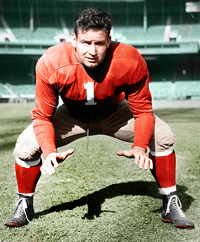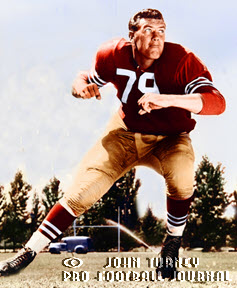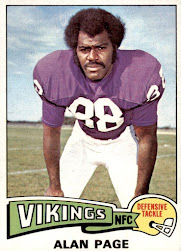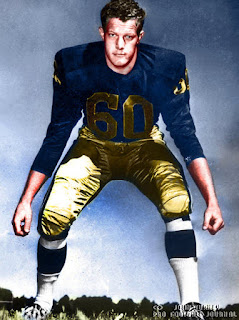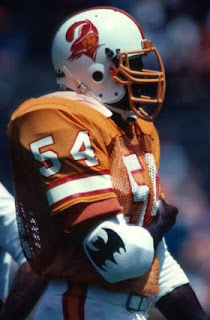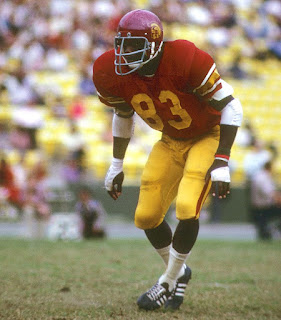LOOKING BACK
By Chris Willis, NFL Films
 |
Ox Emerson, Lions Guard
|
Today PFJ looks
back at one of the NFL’s best guards during the Two-Way Era. Gover “Ox” Emerson,
who played 8 seasons in the NFL with the Portsmouth Spartans-Detroit Lions
(1931-1937) and Brooklyn Dodgers (1938).
The former Texas Longhorn quickly became a stalwart on the Portsmouth
Spartans line in 1931 learning Potsy Clark’s single-wing offense. Emerson used good
strength, speed, and quickness to consistently beat opponents. On film the 5-11,
203-pound Emerson always showed excellent technique and savvy from his guard
position (mainly at right guard), he could also pull from his guard position on
end runs and sweeps in the Lions’ offense. In 1935- after naming Ox to First-team
All-Pro- the UPI wrote: “Emerson plays guard like an end, big, fast and
smart.”
On defense, he was a sure tackler and tough man to block. “(Ox) Emerson, the Detroit guard, is the fastest, ‘slicing’ forward and
the hardest to block, that I ever met in football,” once said Link Lyman, former Chicago Bears Hall of Fame tackle.
 |
| Ox Emerson, Portsmouth Spartans, 1932 |
During
the two-way era (before World War II), Ox Emerson was one of the most decorated
players at his position, earning First-team All-Pro honors from multiple media
outlets, including five straight years by the United Press.
First-team All-Pros:
(5) United Press: 1932, 1933, 1934, 1935, 1936
(4) Collyers Eye Magazine: 1932, 1933,
1934, 1935
(3) Chicago Daily News: 1933, 1934, 1935
(1) Green Bay Press-Gazette: 1935
(1) NFL: 1936
(1) Ray Flaherty:
1936
(1) I.N.S.: 1937
Second-team All-Pros:
NFL: 1934, 1935
(Honorable Mention: 1932, 1938)
Brooklyn
Times-Union:
1934
New York Journal: 1935
Collyer's Eye Magazine: 1936
As well as his many
First-team All-Pro honors, Emerson was easily selected as a member of the NFL’s
1930’s All-Decade Team at guard—along with Dan Fortmann (Bears), Buckets
Goldenberg (Packers) and Russ Letlow (Packers).
Currently, there are 4 Guards from the Two-Way Era in the
Pro Football Hall of Fame: Dan Fortmann, Mike Michalske, Walt Kiesling, and
George Musso (who played some tackle). In this chart below are comparisons of
the guards in the Hall of Fame and on the All-Decade teams of the 1920s &
1930s.
Hall of Fame and All-Decade Guards
Comparison (1920-1939) First-team All-Pros
Dan
Fortmann (HOF, All-Decade) = 6 times
Mike
Michalske (HOF, All-Decade) = 5 times
***Ox
Emerson (All-Decade) = 5 times
Walt
Kiesling (HOF, All-Decade) = 2 times
George
Musso (HOF) = 2 (one each at G-T)
Russ
Letlow (All-Decade) = 1 time
Hunk
Anderson (All-Decade) = 0
Buckets
Goldenberg (All-Decade) = 0
[Note: 1930’s
Buckets Goldenberg (No First-team All-Pros; 120 games, 69 starts; did
win 3 NFL Champ.) 1930s Russ Letlow (2 Pro Bowls, 1 All-Pro, 2 NFL Champ.)]
Looking at his resume Emerson compares very well to the other Hall
of Fame guards of his era.
 |
| Ox Emerson, football pose, 1936 |
Emerson was highly thought of by his opponents during the era he played, especially by the Chicago Bears players from the 1930s—a team that won two championships and lost two during the 1930s.
In 1999 I interviewed two former Bears players who competed against Ox—George Musso, Bears Hall of Fame tackle-guard (1933-1938, 11 games vs Ox) and Charles “Ookie” Miller, Bears All-Pro center (1932-1938, 15 games vs Ox).
Opponents:
“He was an Ox. He was hard to handle. Ox was
just a good guard, hard to block,” said
George Musso.
“I played against Ox several times. He’s fast and
elusive. Tried to out-smart you. Did a lot of times. I tried to do it myself. I
saw what he was doing and I copied him,” said Charles
“Ookie” Miller.
In a 1939 interview with the Associated Press, Bronko Nagurski selected his
own All-time Team. At the guard position he choose Mike Michalske and
Ox Emerson.
In 1955 Red Grange was asked to name a NFL All-Time Team. His chore was to pick 11 players
to win one game. At guard he choose Mike Michalske and Ox Emerson (over Bears
Dan Fortmann). (Source: Nashville Banner, Jan. 12, 1955) “Say, there was a
guard. Ox Emerson, played for (Detroit). Well, I tried for a long while to
figure out how to handle him, but he always fool me,” said Mel Hein in 1939
to Collier’s magazine. (Source: Colliers’, Nov. 4, 1939)
His opponents (Bears,
Giants) confirm that Emerson was
one of the one-two best Guards to ever play in the Two-Way Era.
For 7
seasons, Emerson had a huge impact on the success of the Portsmouth Spartans and Detroit Lions- both on offense & defense…Ox was part of a Lions offensive line
that helped lead the NFL in rushing twice (1936-37) and finish 2nd two
more times (1934-35).
He blocked for Hall of Fame—NFL-100— halfback Dutch Clark
and All-Pros Glenn Presnell, Ernie Caddell, and Ace Gutowsky. “Ox wasn’t very big for a professional
guard, he weighed about 195 pounds. But he was so quick and agile that he made
a lot of tackles and was hard to block. So, he was in the opponent’s backfield
an awful lot. He was very exceptional,” said Glenn Presnell in 1999. Source:
1999 NFL Films interview)
In 1936 the Lions
set an NFL record for rushing yards in a season with 2,885 yards (in 12 games),
a record that stood until 1972 when the undefeated Miami Dolphins broke it (in
a 14-game season; 2,960)…blocked for [Lasted 36 years]. Both teams were heavy
run teams as the Lions ran 80% of the time compared to the Dolphins 70%.
Comparison Chart
of 1936 Lions vs 1972 Dolphins:
1936 Lions: 80%
Run and 20% Pass (total plays = 737 [591 rush. & 146 pass])
1972 Dolphins: 70%
Run and 30% Pass (total plays = 872 [613
rush. & 259 pass])
NFL Record Still
Held:
Emerson was part of an offensive line that helped the Lions establish a NFL
record that still stands today with 426 yards rushing in a single game, Lions
vs Pittsburgh Pirates (now Steelers), on Nov. 4, 1934. (Lions won game, 40-7). That same year Emerson part of a defensive front for the Lions
that started the ‘34 season with an NFL-record 7 straight shutouts- Giving up only
59 points that season, number one in the league.
More proof that Emerson excelled on both offense
and defense (Two-Way Era). A true team player.
 |
| Ox Emerson, football pose, 1932 Green Bay Press-Gazette |
Winning Player:
Emerson played on one of the best teams in the NFL during the 1930’s. The
Spartans-Lions squads were highly competitive under Potsy Clark. Emerson never
had a losing season in 8 NFL seasons (1931-1938) and his teams had an overall
record of 59-28-9 (won .678% of games).
*Bears = 68-21-10
(.764%)
Packers = 67-30-3
(.690%)
Lions = 59-28-9
(.678%) (Dodgers one year in 1938)
Giants = 58-34-7
(.630%)
Redskins = 38-34-7
(.527) (only played from 1932-1937)
*Win-Loss records of
teams from 1931-1938
In 1932 his Portsmouth
Spartans played the Chicago Bears in the famous Indoor Game in Chicago Stadium.
Playing without Dutch Clark the Bears lost, 9-0, missing out on being a world
champion. Three years later Emerson got another chance at a title. A season
that was probably his signature moment in the NFL.
Signature Season/Game:
1935 Detroit Lions, NFL Champions:
In 1935 Emerson
missed the first five games of the season with broken vertebrae in his back.
The Lions struggled without their top lineman, going just 2-2-1. Ox came back
to play the final 7 games with the Lions going 5-1-1 to win the Western Division. “I regard Emerson as one of the greatest linemen
I have ever seen perform on a football field. Having him out of our first five
games hurt us more than anyone will ever know,” said Lions coach Potsy Clark.
 |
| Ox Emerson returns from injury, Detroit News, Oct. 29, 1935 |
A week later they
play in the NFL Championship Game against the Eastern champs- New York Giants-
who were looking to win back-to-back titles.
Emerson helped
Lions defeat Giants in 1935 NFL Champ. Game. Behind a fierce running game, the
Lions only completed just 2 passes (on 5 attempts; 51 yards) and rushed 65
times for 246 yards and 4 TDs. The defense gave up just one TD in a convincing 26-7
victory.
In 1938 Emerson followed Potsy Clark to Brooklyn. The team not quite as talented but still went 4-4-3 (3rd place, eastern). He
would retire after the season.
After stepping
away from the NFL, Emerson worked for Ford Motor Company and served in World
War II. After serving he and his wife Virginia returned to his home state of
Texas, where he coached high school football for years- as well as coach at the
University of Texas (1951-1956). On November 26, 1998, in Austin, Texas Ox
Emerson passed away from pneumonia at the age of 90.
Ox Emerson’s NFL resume has it all:
1) Elite
Player: who was the best at his position during his era (Two-Way Era). Respect
from opponents- especially Chicago Bears (best team from the 1930s).
2) Winner:
Won 1 NFL Championship (1935 Detroit Lions) (Never had a losing season in 8
years)
3) Honors:
Named First-team All-Pro five times; NFL 1930s All-Decade Team
4) Stats:
Helped Lions to establish single-season rushing record in 1936 (12 games) and
were ranked 1-2 in rushing for 4 seasons (1934-1937); played great defense.
5) Signature
Moment: In 1935 with Lions at 2-2-1, comes back after a broken back to guide
the Lions to the NFL Championship (Lions went 6-1-1 when he returned).
Here's remembering a great two-way era player, Ox Emerson!
 |
| Ox Emerson, Univ. of Texas, 1929 |




















